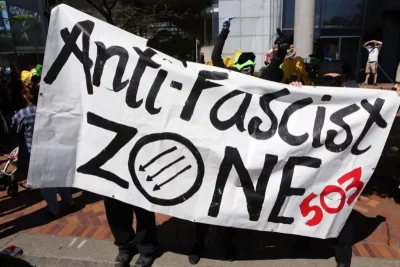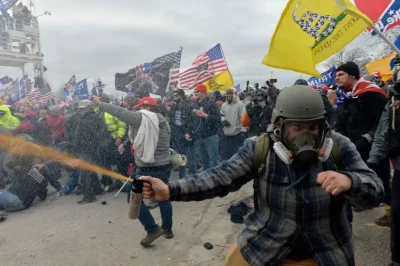
Trump says he will designate the Antifa Movement in the United States as a terrorist organization
Donald Trump has announced that he will designate the Antifa Movement in the United States as a “terrorist organization.”
The president of the United States made the announcement on his social Truth platform on Thursday, describing the antifa as an “sick and dangerous disaster of the radical left.”
He also stated that he will “recommend emphatically” that those who finance the movement be investigated.
Antifa, which is an abbreviation of “anti -fascist”, is a general term for radical leftist activists and does not constitute a unique entity.
It is usually conceived more as a little defined movement, without leaders, formed by protesters and activists.
Trump’s announcement comes after the murder of conservative activist Charlie Kirk on September 10.
And while there was no evidence that connects the murder suspect, Tyler Robinson, to some group, both Trump and high officials of his government repeatedly blamed left groups for creating a climate of hostility against conservatives before Kirk’s murder.
Critics claim that Trump is using Kirk’s murder as a pretext for repressing his political opponents.
Some academics and experts argue that Trump’s announced measure of designating a domestic group or movement as a terrorist organization lacks legal foundation and would violate the first amendment of the Constitution, which protects freedom of expression.
Others question how the president intends to pursue a group that does not have a distinct leader, neither a list of members, nor a formal structure.
But what is Antifa and who does it represent?
Members of the Antifa in an Radical right -wing activist rally Joey Gibson in Oregon in 2018 | Getty Images
What do you oppose?
The antifa is opposed to neo -Nazism, neo -fascism, white supremacy and racism, and, more recently, to the radical right, and what they consider as “growing authoritarianism” in Donald Trump’s government.
The goal of Antifa is to prevent these groups from having a platform to promote their ideas, arguing that their public manifestation leads to attacks against marginalized people, including racial minorities, women and members of the LGBTQ+community.
“The argument is that militant anti -fascism is inherently self -defense due to historically documented violence exercised by fascists, especially against marginalized people,” says Mark Bray, author of “Antifa: The Antifascist Manual” and professor of history at the University of Rutgers.
Although the group is occasionally classified as a left or radical left or left organization, its members have focused on combating radical right -wing ideology, rather than promoting initiatives that represent a particular sector of the political system.
Unlike conventional leftist movements or parties, the group does not seek to obtain power quotas, earn elections or influence the approval of laws in Congress.
With a strong anticapitalist discourse, their tactics have been associated more to those of anarchist groups than to the traditional left.
The antifa has become a frequent target of attacks by right-wing influencers and politicians who consider the movement a fundamental component of a leftist network that, according to them, seeks to undermine freedom of expression, the right to possession of weapons and the American project in general.
How did they come up?
Some antifa groups date the origins of their movement in the struggles against European fascists in the 1920s and 1930s.
The word “Antifa” actually comes from the German Antifaschistisch, which was a German anti -fascist group of the 1930s.
Mark Bray states that the modern American antifaic began in the 1980s with a group called anti -racist action. Its members faced neo-Nazi skinheads at Punk shows in the American Midwest and elsewhere.
But in the early 2000s, the movement had disappeared almost completely in the United States.
He only experienced a new outbreak of interest with the rise of Donald Trump and his first election in 2016.
Since then, Antifa activists have faced each other regularly with radical right -wing protesters and police, both on online heated discussions and in violent protests throughout the United States.
Some examples of these clashes are those that occurred in the demonstrations of the Radical Right in Charlottesville in 2017 and the protests after George Floyd’s murder at the hands of police in Minneapolis in 2020.
 The movement experienced an increase in interest with the rise of Donald Trump and his first election in 2016. Getty Images
The movement experienced an increase in interest with the rise of Donald Trump and his first election in 2016. Getty Images
What are your tactics?
Critics of the movement state that what distinguishes the antifa from the conventional left is the willingness of some activists to use violence to promote their cause.
Antifa’s supporters, in turn, claim that the use of force is in self -defense or to protect their communities.
Their tactics may include the destruction of private property or sometimes physical violence against their opponents.
In 2017, about 100 masked activists, carrying antifa -related bands and flags, attacked a group of right -wing protesters in Berkeley, California, which resulted in several arrests.
During the disturbances that broke out in the United States after George Floyd’s murder in 2020, a self -proclaimed 48 -year -old antifa activist fired and killed a Patriot Prayer sympathizer, a Radical Radical group in the Portland region.
Antifa groups also use more traditional forms of community organization, such as protest manifestations and marches.
As the movement seeks to interrupt events from the radical right and its speakers, they employ various tactics, such as screaming, chanting slogans and forming human currents to block right -wing protesters.
On the internet, their tactics include monitoring the radical right on social networks and also publicizing personal information about their opponents.
Following the murder of Charlie Kirk, BBC Verify found publications by some self -adenominated Antifa members on Reddit and X defending the attack.
The most extremist factions often wear dark clothes and cover the face, being able to carry items such as sticks, shields, pepper spray, knives, bricks and chains.
The lack of a centralized organization means that antifa cells tend to form organically, both online and personally.
Among their activists are anarchists, communists and radical socialists who, in general, share an old disorder, anticapitalist, pro-LGBTQ and pro-immigration opinions.
But antifa is sometimes used as a generic term by conservative politicians and commentators to include other liberal and left -wing groups to which they oppose politically.
A terrorist organization?
It is unclear how the Trump administration plans to label as a terrorist organization which, in fact, is a decentralized movement and without a clear structure or hierarchy, and the White House has not offered more details.
In addition, the movement is a national entity and, as such, is not a candidate to be included in the list of foreign terrorist organizations of the State Department.
This list includes extremist organizations such as the self-adenominated Islamic State and Al Qaeda, and this year were also included several gangs, gangs and Latin American drug cartels.
The designation of “terrorist organization” is important because it implies that foreign members of the group can be expelled from the United States and grants the government the power to confiscate funds and pursue funders.
The movement has been awakened for years of Trump’s wrath, which initially proposed the idea of designating the antifa as a terrorist organization in 2020 amid violent protests across the country after George Floyd’s death.
The then director of the FBI during the first Trump administration, Christopher Wray, said in his statement that the antifa was “an ideology or a movement, not an organization” and, as such, lacked the hierarchical structure that would normally allow him to be designated as a terrorist group by the federal government.
“I don’t know any legal mechanisms that allow us to officially declare a national group as a terrorist organization,” Luke Baumgartner, researcher at George Washington University’s extremism program, told BBC.
“As far as I know, it is just a statement on Truth Social (Trump’s social network) that means nothing and, unless Congress wants to take concrete measures, I don’t believe it will happen,” he said.
Other experts who talked to BBC Verify pointed out that the right to freedom of expression, protected by the first amendment of the Constitution, could limit Trump’s ability to apply such designation.
Professor David Schanzzer, director of the Triangular Center on Terrorism and National Security at Duke University, said: “The first amendment protects the right of association, which encompasses people’s right to form groups and prohibits the government from interfering with the activities of these groups, less, of course, that they have infringed the law.”
“The designation by the president as” important terrorist organization “does not alter these fundamental constitutional rights,” he added.
Brad Evans, professor of political violence at the University of Bath, warned that the lack of an organizational structure and a list of antifa members “gives the government an extraordinary opportunity to broaden its competence.”
This means that anyone suspected of belonging to the antifa would have to prove that they are not associated with it. Extrapolar dangers are more than evident.
Other legal experts question why the Trump government cannot oppose the antifa based on current legislation that deals with crimes such as incitement to violence.
Trump’s announcement is part of a wider campaign he undertook against what he calls the “radical left” after Charlie Kirk’s murder.
The president stated that “the political violence of the radical left damaged many innocent people and cost many lives.”
Authorities confirmed that Tyler Robinson, accused of Kirk’s murder, had a “leftist ideology,” but did not provide many details and he was not directly related to Antifa.
Is there right political violence?
 According to independent studies analyzed by BBC Verify, in recent decades there has been more political violence by the right than on the left. | AFP via Getty Images
According to independent studies analyzed by BBC Verify, in recent decades there has been more political violence by the right than on the left. | AFP via Getty Images
This week, the Justice Department eliminated a study of political violence in the United States that concluded that the right -wing radical extremism surpassed “all other types of violent extremism.”
The BBC asked why this study, published in 2024 by the department’s investigation agency, had been eliminated. The Justice Department replied that “had no comments” about it.
BBC Verify has analyzed five independent studies that have examined attacks on political reasons in the United States in recent decades, and they all suggest that there have been more cases of political violence in the US committed by people that researchers have classified as right -wing than left -wing ideology.
However, as there is no coherent or universal definition of “right” and “left”, it is difficult to measure the trends of political violence over time.
Professor Robert Pape, from the University of Chicago, said that in recent years “historical levels of political murders and murder attempts” have been recorded, both from republican and democratic politicians.
“What we see in our data about what happens when a political leader blames one of the parties for violence is that there is an increase in support for political violence, not a decrease,” he added.
Originally published by BBC News on 19/09/2025
Por Shanyaride
Source: https://www.ocafezinho.com/2025/09/21/o-que-e-o-antifa-movimento-que-trump-quer-declarar-como-grupo-terrorista/

